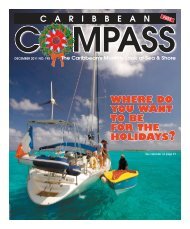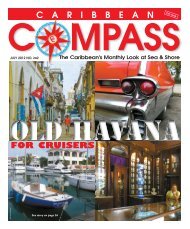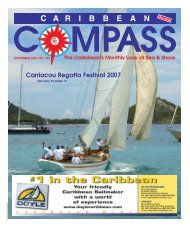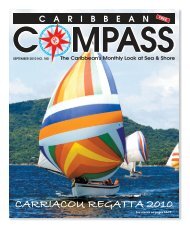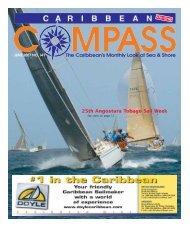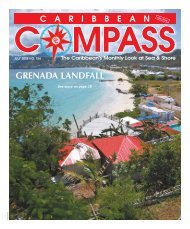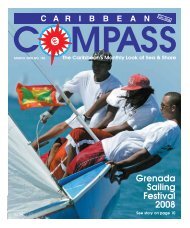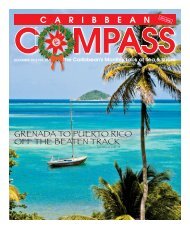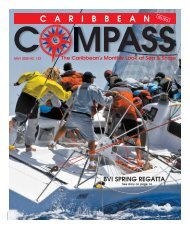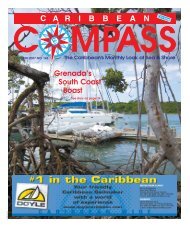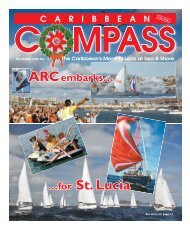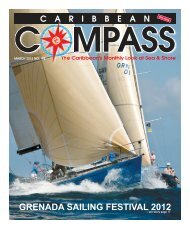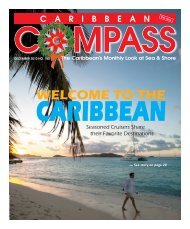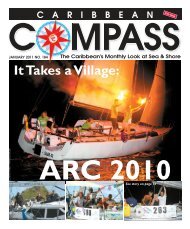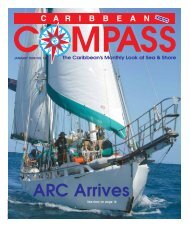A CRUISER'S VIEW OF BEQUIA - Caribbean Compass
A CRUISER'S VIEW OF BEQUIA - Caribbean Compass
A CRUISER'S VIEW OF BEQUIA - Caribbean Compass
Create successful ePaper yourself
Turn your PDF publications into a flip-book with our unique Google optimized e-Paper software.
D<br />
uring my travels, when I compare cultures with the people I meet, most of them comment that we<br />
Trinidadians take Christmas to the extreme. From August, advertisements go in the newspapers about<br />
sales on various types of merchandise, and if you close your eyes you may be able to smell “black cake”<br />
baking. But I am getting a bit ahead of myself.<br />
Christmas celebrations in Trinidad really begin in September or October with the start of the parang season,<br />
which continues until 6th of January. Especially popular in Trinidad and Tobago, parang is a genre of <strong>Caribbean</strong><br />
folk music with origins in South America. Traditionally the songs contain religious (Christian) lyrics, but now they<br />
include a variety of topics and customs surrounding the Christmas celebrations in the country. Singing parang<br />
from house to house was our version of caroling. At each house, the parranderos would get a piece of ham — if<br />
the ham was not ready they would just get a drink. Nowadays, parang is more often done on a national competition<br />
level rather than at a community level except in some rural communities.<br />
To others the first sign of Christmas is the “Christmas Breeze”, which to me has a hint of a chill.<br />
I do agree with the observation that we have the habit that everything in a Trinidadian household must be perfect<br />
for Christmas Day. This includes new curtains, furniture and appliances. It is not uncommon to see furniture<br />
trucks parked outside of houses, delivering new sofa sets or refrigerators and washing machines. (Of course, when<br />
the holiday season is over it is another common sight to see “repo” trucks outside these same homes if the new<br />
owners failed to make the payments. The furniture ends up in “scratch and dent” sales that follow the holidays.)<br />
Most of us like brand-new curtains, and it is not uncommon to see people with packs of ready-made panel curtains<br />
piled up in their arms, or in the process of deciding which colour will go best with a piece of furniture or wall<br />
colour, or sometimes just trying to remember what colour combination they hung up last year so as not to buy the<br />
same thing again. These brand-new treasures get hung up a few weeks before the big day or on Christmas Eve.<br />
Having fresh floral arrangements was not a common practice in the past, so flowers made from crepe paper and<br />
secured to a strand of cocyea (coconut frond spine) with string were used as decorations. Artificial flowers are<br />
still popular.<br />
TRINI CHRISTMAS —<br />
PAST AND PRESENT<br />
by Jo-Anne Nina Sewlal<br />
Also, when Trinidadians paint for Christmas they paint everything — inside and outside. The entire house is<br />
turned inside out and in each room the furniture is piled in the middle while the walls are being painted.<br />
In the past there was a lot of pride taken in the furniture owned, particularly since it was very expensive to<br />
obtain. So every year around Christmas time all the furniture would get a coat of varnish while the wooden floors<br />
got a coat of lacquer. Many a time guests have become stuck, because amidst the celebrations the homeowners<br />
forgot to notify them that the furniture had just been varnished! Last-minute painting has always seemed to be a<br />
tradition of a Trini Christmas.<br />
When do we get the time to do all of this? Well, the answer is “when we can”, be it after work or school. And<br />
when the school vacation rolls around, well, then there is even more activity with the children pitching in with<br />
the preparations.<br />
Sometimes it seemed as though everyone was in the yard doing something. The women were boiling the<br />
Christmas ham in a biscuit tin (salted crackers used to come in large square metal tins) on an outdoor fire. The<br />
children played outdoors, the reason being that the house steps and floors had been painted, as well as the walls,<br />
so that you could not go inside even if you wanted to. And who would want to with all the hustle, bustle and excitement<br />
going on in the yard?<br />
When it came to food, like most cultures at special times you would partake of those that were quite expensive<br />
as well as not present all year round. Common examples included fruits such as apples, grapes and pears. These<br />
were a luxury, as they were rarely imported except around Christmas time. Other items on a typical Christmas<br />
menu included a variety of desserts such as sponge cake, sweet bread, and black cake, the latter being the<br />
<strong>Caribbean</strong> version of a fruitcake. This is filled with fruits soaked in rum, and after baking preserved by pouring<br />
some rum on it every few days.<br />
Christmas breakfast consisted<br />
of black pudding and hops bread<br />
EEven th the way the th cakes k were baked b k d was interesting. i t ti If you were lucky l k back b kth then, you possessed d a tin ti oven. These Th<br />
large square ovens were placed on top of the burners of kerosene stoves, the object being that the hot tin would bake<br />
the contents inside. If you didn’t have a kerosene stove, you would place it on an outdoor fire or use a clay oven.<br />
Using a clay oven was quite a process, in that first a fire had to be lit inside in order to heat up the clay. When<br />
this had been reduced to ashes the oven was swept out and the breads and pastries placed inside. A wooden door<br />
was put in place and the space around the door was sealed with wet cloth bags. Not everyone in the village would<br />
own a clay oven and you would have to use your neighbours’, which meant paying a user fee (usually 25 cents, or<br />
one of the breads or pastries). So it was not unusual to see a line of people with their ingredients and baking tins,<br />
waiting their turn to use the oven.<br />
Another method, usually reserved for small households, was to place the baking tin in a pot on an outdoor fire.<br />
The pot was covered with a small sheet of “galvanise” (metal) and a fire built on top of this to simulate the action of<br />
an oven.<br />
Some other types of food eaten at Christmas are from a variety of cultures that have occupied the islands at some<br />
point in history. These include black pudding (blood sausage) from our British ancestors. A traditional “ole time”<br />
Christmas breakfast consisted of black pudding and hops bread (you can think of it as a tough hamburger bun).<br />
At Christmas time, we make pastelles, an indigenous Amerindian food that the Mexicans call tamales. The soft<br />
cornmeal dough is rolled to form a thin circle and vegetables or meats such as beef or pork are placed in the<br />
middle, and then wrapped in the dough. The parcel is then wrapped in pieces of banana leaves that have been<br />
boiled to sterilize them and to make them pliable. The wrapped parcels are tied with string and boiled for 45 minutes<br />
to an hour. We also make paimees. Here the cornmeal mixture used to make the pastelles is formed into a<br />
ball, wrapped the same way and boiled.<br />
When it comes to drinks, we usually make pretty, red sorrel, which is made from boiling the sepals of the sorrel<br />
fruit (roselle, or Hibiscus sabdariffa) with spices such as cinnamon and cloves and straining the mixture. For<br />
ginger beer, the ginger roots are either grated or smashed using a mortar and pestle, and placed in a jug with<br />
cloves and water and left overnight. In the old days the ginger mixture would be placed in the sun for a few days.<br />
What has always been a staple is Peardrax (a pear-flavoured soft drink), which was and still is treated as nonalcoholic<br />
champagne.<br />
The most exciting part of all the weeks and months of Christmas preparations in Trinidad is that most of these<br />
activities — the painting, cooking, baking and decorating — ends up getting done on Christmas Eve.<br />
What you have to remember is that times were very hard during the early part of the 20th century and some of<br />
the holiday practices we retain from those days may seem primitive by our current standards. But that does nothing<br />
to take away from the Christmas spirit. But whether these traditional activities have remained the same or<br />
have just been modified, when it comes to Christmas in Trinidad, “we don’t make joke”!<br />
STREET’S GUIDES<br />
ARE MORE ECONOMICAL!<br />
Written by an author with 50 years of sailing<br />
experience in the <strong>Caribbean</strong>, the series’ four volumes<br />
cover the Eastern <strong>Caribbean</strong> from Puerto Rico<br />
down through the islands and<br />
the coast of Venezuela to the ABCs.<br />
REAL SAILORS<br />
BUY STREET’S GUIDES<br />
Real sailors use Street’s Guides for inter-island and harbor<br />
piloting directions, plus interesting anecdotes of people,<br />
places and history. Street’s Guides are the only ones that<br />
describe ALL the anchorages in the Eastern <strong>Caribbean</strong>.<br />
NEW! Street’s videos, first made in 1985,<br />
are now back as DVDs.<br />
• “Transatlantic with Street” documents a sailing passage<br />
from Ireland to Antigua via the Cape Verdes. 2 hours<br />
• “Antigua Week ’85” is the story of the engineless yawl Iolaire<br />
racing round the buoys to celebrate her 80th birthday. 1 hour<br />
• “Street on Knots” demonstrates the essential knots and<br />
line-handling skills every sailor should know. 1 hour<br />
All are available via Armchair Sailor and Bluewater Books.<br />
HURRICANE TIPS! Visit www.street-iolaire.com for a wealth of<br />
information on tracking and securing for a storm.<br />
Street’s Guides are available<br />
at bookshops and chandleries, or from<br />
www.iUniverse.com and www.seabooks.com<br />
NOVEMBER 2008 CARIBBEAN COMPASS PAGE 43



